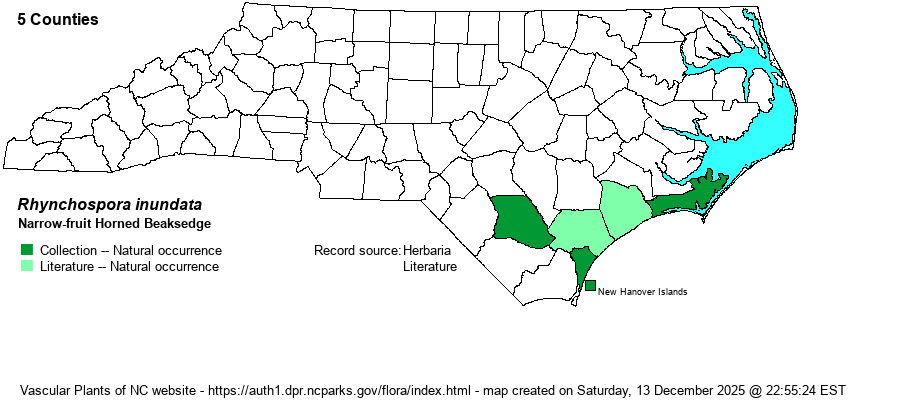| Author | (Oakes) Fernald | |
| Distribution | Outer Coastal Plain, plus Bladen County. Only verified specimens have been mapped, plus likely reports from Onslow and Pender counties (Richard LeBlond). A specimen from Brunswick County (Morris 082505-09 NCU) is actually R. macrostachya. Reports at NCNHP from Hoke, Robeson, and Scotland counties are actually R. careyana from clay-based Carolina bays.
Coastal Plain, southeastern MA to southern FL to eastern TX. Quite disjunct; not known from VA or CT. | |
| Abundance | Rare, possibly uncommon. The NCNHP's State Rank of S3 presumably includes almost certain misidentified records farther inland that include clay-based bays; a more realistic State Rank, recommended by the editors, is S2?. Either way, this is a Watch List species. | |
| Habitat | Natural depression ponds, sinkhole ponds, interdune depression ponds. |
| Phenology | Flowering and fruiting July-September. | |
| Identification | With its robust size and very open inflorescences, this species is often confused with R. corniculata and R. careyana. From them it differs by the seed bristles being much longer than the seed body, versus equal to or shorter in the other two species. From R. macrostachya it differs in the very open inflorescence (vs. tight clusters) and the presence of long horizontal rhizomes (vs. none in that species). | |
| Taxonomic Comments | None
Members of the genus Rhynchospora -- mainly called beaksedges but also called beakrushes -- are mostly Coastal Plain in distribution and are important members of our longleaf pine savannas, flatwoods, streamheads, depression ponds, Carolina bays, and beaver ponds. They vary from small and wiry to large and coarse. Keys concentrate on features of the achenes (seeds) and the shape and arrangement of the flower clusters (spikelets). The seeds may or not have bristles at their base; bristle number, length, and toothing are critical characters. Size and shape of the seed beaks is also critical. The drawings in Godfrey & Wooten (1979) are extremely helpful. The genus now includes Dichromena, the white-topped sedges. | |
| Other Common Name(s) | None | |
| State Rank | S3 [S2?] | |
| Global Rank | G4? | |
| State Status | W1 [W7] | |
| US Status | | |
| USACE-agcp | OBL link |
| USACE-emp | OBL link |

